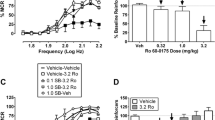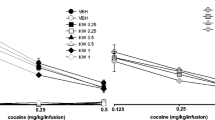Abstract
The present study was designed to investigate the effect of U-50, 488H, a highly selective kappa opioid agonist, on ipsilateral and contralateral circling behavior induced by methamphetamine and by apomorphine, respectively. U-50, 488H (3.2–10 mg/kg IP) by itself failed to induce either ipsilateral or contralateral circling in rats with unilateral nigral lesions produced by an injection of 6-hydroxydopamine. U-50, 488H produced a significant dosedependent inhibition of methamphetamine (1.0 mg/kg SC)elicited ipsilateral circling. However, it had no effect on contralateral circling induced by apomorphine (0.5 mg/kg SC). The present results indicate that U-50, 488H presynaptically inhibits the release of dopamine in the rat striatum.
Similar content being viewed by others
References
Ayhan IH, Randrup A (1973) Behavioural and pharmacological studies on morphine-induced excitation of rats: possible relation to brain catecholamines. Psychopharmacologia 29: 317–328
Castellano C, Pavone F (1985) Effects of bremazocine on locomotor activity in DBA/2 and C57BL/6 mice. Arch Int Pharmacodyn Ther 278: 45–52
Costal B, Naylor RJ, Pycock C (1975) The 6-hydroxydopamine rotational model for the detection of dopamine agonist activity: reliability of effect from different locations of 6-hydroxydopamine. J Pharm Pharmacol 27: 943–946
Di Chiara G, Imperato A (1988) Opposite effects of mu and kappa opiate agonists on dopamine release in the nucleus accumbens and in the dorsal caudate of freely moving rats. J Pharmacol Exp Ther 244: 1067–1080
Di Chiara G, Vargiu L, Porceddu ML, Longoni R, Mulas A, Gessa GL (1977) Indirect activation of the DA system as a possible mechanism for the stimulatory effects of narcotic analgesics. In: Costa E, Gessa GL (eds) Advances in biochemical psychopharmacology, vol 16. Raven Press, New York, pp 571–575
Gauchy C, Agid Y, Glowinski J, Cheramy A (1973) Acute effects of morphine on dopamine synthesis and release and tyrosine metabolism in the rat striatum. Eur J Pharmacol 22: 311–319
Geller EB, Hawk C, Tallarida RJ, Adler MW (1982) Postulated thermoregulatory roles for different opiate receptors in rats. Life Sci 31: 2241–2244
Geller EB, Hawk C, Keinath SH, Tallarida RJ, Adler MW (1983) Subclasses of opioids on body temperature change in rats: acute subcutaneous administration. J Pharmacol Exp Ther 225: 391–398
Huidobro-Toro JP, Parada S (1985) κ-Opiates and urination: pharmacological evidence for an endogenous role of the κ-opiate receptor in fluid and electrolyte balance. Eur J Pharmacol 107: 1–10
Iwamoto ET (1981) Locomotor activity and antinociception after putative mu, kappa and sigma opioid receptor agonists in the rat: influence of dopaminergic agonists and antagonists. J Pharmacol Exp Ther 217: 451–460
Iwamoto ET, Loh HH, Way EL (1976) Circling behavior after narcotic drugs and during naloxone-precipitated abstinence in rats with unilateral nigral lesions. J Pharmacol Exp Ther 197: 503–516
Iwatsubo K, Clouet DH (1977) Effects of morphine and haloperidol on the electrical activity of rat nigrostriatal neurons. J Pharmacol Exp Ther 202: 429–436
Lahti RA, Von Voigtlander PF, Barsuhn C (1982) Properties of a selective kappa agonist, U-50, 488H. Life Sci 31: 2257–2260
Leander JD (1983) A kappa opioid effect: increased urination in the rat. J Pharmacol Exp Ther 224: 89–94
Lord JAH, Waterfield AA, Hughes J, Kosterlitz HW (1977) Endogenous opioid peptides: multiple agonists and receptors. Nature 267: 495–499
Martin WR, Eades CG, Thompson JA, Huppler RE, Gilbert PE (1976) The effects of morphine- and nalorphine-like drugs in the nondependent and morphine-dependent chronic spinal dog. J Pharmacol Exp Ther 197: 517–532
Mulder AH, Wardeh G, Hogenboom F, Frankhuyzen AL (1984) κ- and δ-opioid receptor agonists differentially inhibit striatal dopamine and acetylcholine release. Nature 308: 278–280
Paxinos G, Watson C (1982) The rat brain in stereotaxic coordinates. Academic Press, New York
Schulz R, Faase E, Wüster M, Herz A (1979) Selective receptors for β-endorphin on the rat vas deferens. Life Sci 24: 843–850
Sugrue MF (1974) The effects of acutely administered analgesics on the turnover of noradrenaline and dopamine in various regions of the rat brain. Br J Pharmacol 52: 159–165
Ungerstedt U (1971a) Striatal dopamine release after amphetamine or nerve degeneration revealed by rotational behaviour. Acta Physiol Scand [Suppl] 367: 49–68
Ungerstedt U (1971b) Postsynaptic supersensitivity after 6-hydroxydopamine induced degeneration of the nigro-striatal dopamine system. Acta Physiol Scand [Suppl] 367: 69–93
Ungerstedt U, Arbuthnott GW (1970) Quantitative recording of rotational behavior in rats after 6-hydroxydopamine lesions of the nigrostriatal dopamine system. Brain Res 24: 485–493
Von Voigtlander PF, Lahti RA, Ludens JH (1983) U-50, 488: a selective and structurally novel non-mu (kappa) opioid agonist. J Pharmacol Exp Ther 224: 7–12
Walker JM, Thompson LA, Frascella J, Friederich MW (1987) Opposite effects of μ and κ opiates on the firing-rate of dopamine cells in the substantia nigra of the rat. Eur J Pharmacol 134: 53–59
Wood PL, Stotland M, Richard JW, Rackham A (1980) Actions of mu, kappa, sigma, delta and agonist/antagonist opiates on striatal dopaminergic function. J Pharmacol Exp Ther 215: 697–703
Author information
Authors and Affiliations
Rights and permissions
About this article
Cite this article
Ohno, M., Yamamoto, T. & Ueki, S. Inhibitory effect of a selective kappa receptor agonist, U-50, 488H, on methamphetamine-elicited ipsilateral circling behavior in rats with unilateral nigral lesions. Psychopharmacology 97, 219–221 (1989). https://doi.org/10.1007/BF00442253
Received:
Accepted:
Issue Date:
DOI: https://doi.org/10.1007/BF00442253




